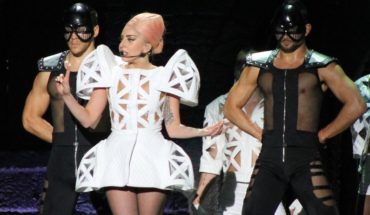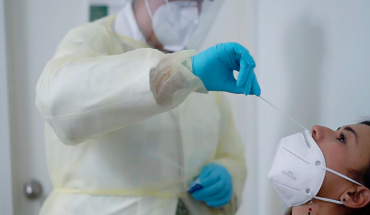The cold already greets her with open arms. With nearly five years of experience in deep-water sbathing – and more than 25 years in conventional stanging – Bárbara Hernández (33) has been accumulating countless awards and recognitions. Without going any further, it has been for two consecutive years the number one ranking of the International Winter Swimming Association (IWSA) in Category C, since it still retains. There’s a reason they call him the Ice Mermaid.
Recoletana by birth, Hernández started swimming at the age of seven, in the pool of the University of Chile. The link to that study house kept her in her university years, where she studied psychology and then pulled out a master’s.
But Hernandez’s passion was always found in the water. At 17, he started swimming in open water. “I wanted to swim in the Strait of Magellan, following in the footsteps of the ‘Shark’ Contreras,” he recalls. It wasn’t until 2014 that he made the leap into the icy waters.
Barbara Hernandez. Photo: THD. Side
The most recent triumph of the Ice Mermaid was in the fifth edition of the Tyumen Open Cup, one of the stages of the Winter Swimming World Cup. In the competition, Barbara won 10 medals: three gold and seven silver.
However, neither the turbulent waters in which it has plunged, nor the cold that borders zero degrees, have the density of another great challenge, one poorly known by Chilean athletes. “The hardest thing is always looking for financial support,” Hernandez says.
The countercurrent
For every competition Barbara spends between seven and 10 million pesos. “Those are the activities i’ve signed up for, where I have a place, where I earned my spot, so I hope to get money out of where verily,” he says.
At the moment, two institutions finance it: the Initial Impulse Foundation, by Andronic Luksic, and the Ministry of Sport. But it still doesn’t be enough for him to adequately cover all the challenges he wants to face.
How much funding is given to you by the Ministry of Sport?
Last year I had a support of 10 million pesos. That was enough for me only for one channel and last year I did the Catalina Channel, which was 10 million, English Channel, I had four ice races competing in Europe, twice in Russia, once in Finland, and so, to be able to validate the number one in the world ranking that already it’s mine and I hope to revalidate this year again. And it’s not enough. In the end, all I get together in support is what I distribute in costing my donations, in the races.
I’ve already spent all my savings, i’m very likely to go back to my parents’ house this summer and sell the car that I bought with so much effort, but they are unique opportunities. Being able to compete for Chile, being able to swim this journey, are really unique opportunities.
How long has the Ministry been funding you?
This would be my third or fourth year. Initially it was with a support of five million. Last year was the first time with 10. I hope this year I wish the same sum or a little more, or that it will reach me to cover even a complete sun.
Do you also work in parallel?
Last year I stopped working, but I’ve always worked. Last year I quit because marathons require you to train in pool four hours a day plus physical preparation, which is two hours a day, more yoga, add an hour more, plus nutrition, kine and seek support. I don’t have hours left to sleep, so I decided this year full training, so I gathered as many marathons and all the competitions and try to live and eat with what I can, with the support of my family of course.
2020: of the Seven Seas and other challenges
Being number one in the IWSA ranking is a rigid discipline. The swimmer trains from 6 to 10 a.m. at the National Stadium, every day. He then does weights at the High Performance Center, then do yoga, three times a week. To acclimatize to low temperatures and open water, the “Ice Mermaid” is prepared in the Inca Lagoon and also at sea. In addition, he tries to travel to Patagonia at least once a year.
With all this training behind him, Hernandez faced last year a challenge he cloistered for 15 years: the English Channel. The one known as the English Channel separates the French coast from that of Britain and is considered one of the great challenges for open water swimmers. Barbara was the first Chilean to cross it, covering 34 kilometers in 12 hours and 13 minutes.
The Macha Canal is part of the Seven Seas Challenge, the equivalent of the Seven Mountaineering Summits. According to LongSwims Database, only 19 people have completed it. The Chilean is committed to overcoming the challenge and becoming the first South American woman to achieve it. He has already crowned three crosses of the list (Catalina Canal, Strait of Gibraltar and English Channel); now only the North Channel, Molokai Canal, Cook Strait and Tsugaru Strait remain.
To cross the English Channel you took about 12 hours How do you mentally prepare for such long days?
It is the confidence that gives you physical preparation, also the knowledge that I trained every day from Monday to Saturday, four hours a day in the pool, continues, because many swimmers do double shift but what served me was the stay in the water. Besides feeling physically strong, it helps you mentally feel more confident too, because one says good, the preparation I already did, I listened to the coach, the nutrition, the kine, like everyone, and now when you already throw yourself in the water it’s like really doing what you do. you went to do.
Across the English Channel. Photo: THD. Side
Has the English Channel been the toughest challenge you’ve ever faced?
I don’t know if the most difficult, because in nature, in the middle of nowhere, you never know what the end result is going to be. If I think it’s more respect, more affection, and I think it marks a before and after. Internationally, open water swimmers recognize them like this: you crossed the English Channel or not. That’s the division and of course it fills me with pride to be the first Chilean woman to have crossed it.
What will be your next challenge in the Seven Seas Challenge?
My next challenge is North Channel, Iceland-Scotland. It’s 35 kilometers in water at 12 degrees, which is very cold, because I’m going to be swimming at least 15 hours. There are many jellyfish called lion mane jellyfish, which are giant bugs with yellow issues, very painful otherwise. That’s in August. In October I have the Molokai Canal, in Hawaii, which is 47 kilometers and there are sharks, so I hope none will appear so I can finish swimming. Wish.
Before that I finish my triple crown in open water swimming, it is an international recognition also very important, where I would be the first Chilean person to obtain it, which is the return Manhattan, of 37 kilometers, in June. Those are the marathons that I have for this year 2020, they are all very complex, very difficult, very painful, but very entertaining too, very challenging.
New generations
Despite the explosive success in Barbara’s career, deep-water softening is still very unknown in Chile. She wants to reverse this and add more fans to the discipline.
Do you know other Chilean swimmers who have focused on swimming in icy waters?
No, no one, for now. I think the generations that come are going to get a little bit of hooking like all this work I’ve been doing, and it’s my goal too, to motivate more and more people. But I think that’s where we’re at the right in swimming in general.
Before we want to be an extreme swimmer, swimming on ice in zero-degree waters, we first have to have swimmers and have swimming schools that are cross-cutting, where I wish all Chile could opt, especially in regions, because people who know how to swim in Chile continue to swim being a minority, being that we have an infinite coastline, natural resources of lakes, rivers, and people do not know how to swim. Swimming remains a privilege rather than a life-saving sport, especially in the farthest regions.
What would you say to a young man who is aspiring to be a swimswimr in icy waters?
First you’re a swimswimr, you’re advised by a professional team, because it’s an extreme sport, then there are associated medical risks that are super real.
I mean, there are people swimming in ice, and they do. That’s why it’s so important to have the previous knowledge of swimming, of open water swimming, it’s a process, and to get advised by a team: having a coach, having physical preparation, getting medical exams. There has to be a medical check-up every time, because you finally defy the body, it pushes you to the limit. Swimming at zero degrees for more than 25 minutes is really risky.
Having all that, let it begin, first on our shores. Our sea is cold and from there gradually lower the temperature until we can already reach compete in these conditions.
“The only failure is to stop trying”
What is your greatest fear of playing this sport?
My biggest fear I think is sometimes like feeling like I’m failing people who have believed in me. I’m not afraid of a shark eating me, I mean I’m afraid, obviously, but it’s not something that distresses me. It’s like when the time came maybe I can’t finish. And there I also answer myself immediately when I see that fear. The only failure is to stop trying. So I know that people will know, the people who love me, the people who have seen all my effort, that I am not one to abandon, I am one of those who tries to the end, and that if for some reason could not finish some crossing , I didn’t wait for anything and I don’t regretor anything.
What has been the greatest teaching that has left you when you are nuned in icy waters?
My greatest teaching has been tolerance for frustration and then being willing to start from scratch so many times necessary. Not the times that I want or want, that I usually wish it were one, but really as many times as necessary. I believe that this is a teaching for life and that it has taught me to get over everything, to tolerate pain, to tolerate frustration, to persist, to believe in my passion and to be willing to help others.
translated from Spanish: “The hardest part is to seek economic support”: the countercurrent of Bárbara Hernández, the Chilean who is a world champion of water in icy waters
January 29, 2020 |





